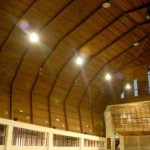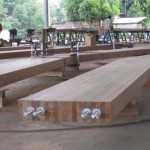Babbo bimatoprost is a prescription medication used for the treatment of glaucoma. The use of conventional wood in buildings could some day become a thing of the past as a new Glulam offers greater potential for the construction and furniture industry.
Akhtubinsk Known as glue laminated timber or ‘Glulam’, it is made by binding either the same or different wood species with strong adhesive. Glulam is custom-made in various section sizes, lengths and shapes that provide great flexibility in fulfilling the needs of the construction and furniture industry.
The Malaysian Timber Industry Board’s (MTIB) iconic timber building in Tebrau, Johor Bahru, showcases Glulam’s almost unlimited design flexibility and structural strength.
The MTIB building, completed in December 2011, serves as a centre to promote the use of locally produced Glulam in the construction of buildings, homes and furniture for the future.
The MTIB building is the first such centre in the world to use glulam, made from two hard woods found in Malaysia – Resak and Keruing – for its structure. By bonding the woods, greater spans and structural strength were achieved, unlike conventional wood where the span is limited and the structural strength is affected by the maximum span.
This was the first tall building in Malaysia where load-bearing timbers were used for its structure thus reflecting the commitment to innovation in the Malaysian construction sector.
The centre, costing RM24 million with a surface area of 3,700 square meters, is divided into three sectors – Exhibition Hall, Product Gallery and Administrative Centre.
Safety was not compromised in using this method – in the event of fire the structural integrity of Glulam lasts much longer than steel. The fire resistance properties and durability of Glulam have been tested. The Centre’s design was also based on the Green Building Index to ensure its environmental credentials.
Woodsfield Engineering were contracted to manufacture the glue laminated sections. Rotafix were technical consultants on the project for the manufacture and installation of the glulam structure and worked closely with Woodsfield Engineering and Associate Professor Dr. Zakiah Ahmad,Faculty of Civil Engineering, Universiti Teknologi Mara, Malaysia.
Straight sections of Glulam were manufactured by Woodsfield Engineering in their factory in Malaysia. The glue laminated sections were then drilled in order to receive the controlled injection of Rotafix Structural Adhesive (RSA) followed by insertion of shear rods.
RSA was extensively tested by the University of Bath to ensure that the structural properties of the adhesive would not be compromised by the high temperature and humidity present in Malaysia.
Once proven, RSA was specified for all connections. The adhesives were manufactured by Rotafix who exported the equipment and materials to Malaysia.
Dave Smedley, Rotafix Managing/Technical Director and Gareth Jones General Manager, of Rotafix, trained the Woodsfield technicians and provided technical support across each stage of the project.
At the Woodsfield Johor based factory the RSA was injected to full depth into the holes in the Glulam sections using grouting tube. Despite the warm humid conditions in Malaysia, RSA was ideal as its slow setting nature gave the engineers and technicians time to assemble the joints.
The individual sections of Glulam beam were connected via a series of both hidden and exposed connections. The picture above shows one of the 70kg shoes that were attached to the concrete foundations. The photograph below shows the rods that were used to create a butt joint timber to timber. The thick film of RSA is seen as an annulus around the rod. The adhesive penetrated 3-4mm into the hardwood giving excellent bond strength.
The frame was constructed by joining the straight sections with the angled ends. Some sections of Glulam were assembled at the Woodsfield factory to reduce the amount of time on site, thereby improving the speed of the build and reducing the costs for on-site cranes and operatives.
The pre-assembled sections were then transported to site and assembled into three frames thus forming the free span roof sections.
Once the frames had been erected they were covered with 10mm thick plywood, then covered with 0.3mm zinc sheets and finally covered with 350,000 Belian shingles, all hand applied.
The photograph below shows the foot of the Glulam section attached the foundations. The timber was raised from the floor to reduce the possibility of moisture inducing decay in the end sections of the glue laminated timber.
The studs used to attach the shoes to the Glulam feet were bonded into the foundations using Rotafix Zeroset Anchor Grout. This product was developed specifically for use in diamond core drilled holes in reinforced concrete capable of displacing water and enabling curing to provide a solid anchor point.
Rotafix are able to provide comprehensive technical support for architects, structural engineers and contractors carrying out this type of construction with Glulam or solid timber.
For further information about products used in this project or any queries with respect to structural adhesives and on-site bonding please contact us on +44 (0)1639 730481 where one of our technical team will be happy to assist.













